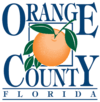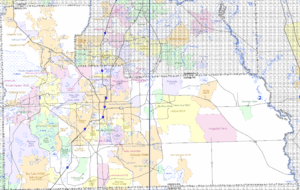Orange County, Florida facts for kids
Quick facts for kids
Orange County
|
|||
|---|---|---|---|
| County of Orange | |||
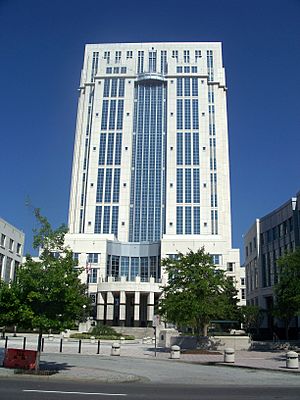
The Orange County Courthouse in Orlando
|
|||
|
|||
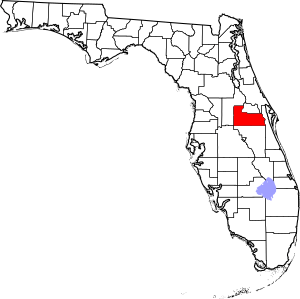
Location within the U.S. state of Florida
|
|||
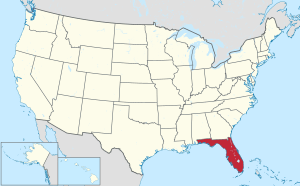 Florida's location within the U.S. |
|||
| Country | |||
| State | |||
| Founded | December 29, 1824 (renamed January 30, 1845) | ||
| Named for | Orange fruit | ||
| Seat | Orlando | ||
| Largest city | Orlando | ||
| Area | |||
| • Total | 1,003 sq mi (2,600 km2) | ||
| • Land | 903 sq mi (2,340 km2) | ||
| • Water | 100 sq mi (300 km2) | ||
| Population
(2020)
|
|||
| • Total | 1,429,908 | ||
| • Density | 1,493.88/sq mi (576.79/km2) | ||
| Time zone | UTC−5 (Eastern) | ||
| • Summer (DST) | UTC−4 (EDT) | ||
| Congressional districts | 7th, 8th, 9th, 10th | ||
Orange County is located in the central portion of the U.S. state of Florida. As of the 2020 census, the population was 1,429,908, making it Florida's fifth most populous county. The county seat is Orlando. Orange County is the central county of the Orlando-Kissimmee-Sanford, Florida Metropolitan Statistical Area.
Contents
History
The land that is Orange County was part of the first land to emerge from below the Early Oligocene sea 33.9–28.4 million years ago and is known as Orange Island. Orange County's Rock Spring location is a Pleistocene fossil bearing area and has yielded a vast variety of birds and mammals including giant sloth, mammoth, camel, and the dire wolf dating around 1.1 million years ago.
In 1821, two counties formed Florida: Escambia to the west and St. Johns to the east. In 1824, the area to the south of St. Johns County became Mosquito County, and Enterprise was named the county seat. This massive county took up much of central Florida. Mosquito County was renamed Orange County in 1845 when Florida became a state. Several counties, such as Osceola, Seminole, Lake, and Volusia were carved out of Orange County.
Orange County was renamed from Mosquito County for the fruit that constituted the county's main product. At its peak in the early 1970s, some 80,000 acres (320 km2) were planted in citrus in Orange County.
The financial setbacks, not the first in the grove region's history, were too challenging for many growers. Economically destroyed, many walked away from the land and its obligations. Others awaited other opportunities. One of the region's major land owners and growers was the Tropicana company. They, however, also withdrew rather than try to come back from these seemingly endless generational decimation. With no realistic avenues for agricultural use of this rural land, and Florida's continuing strong population growth and its attendant needs (aided and supported by the success of nearby Walt Disney World and Universal Studios Florida), these areas began and continue to be swallowed up by growing housing developments. However, several packing facilities and wholesalers are still in Orange County.
Geography
According to the U.S. Census Bureau, the county has a total area of 1,003 square miles (2,600 km2), of which 903 square miles (2,340 km2) is land and 100 square miles (260 km2) (10.0%) is water.
Adjacent counties
- Seminole County - north
- Volusia County - northeast
- Brevard County - east
- Osceola County - south
- Polk County - southwest
- Lake County - west
Transportation
Airports
- Orlando Apopka Airport, a privately owned uncontrolled, public-use airport in the City of Apopka which serves small private aircraft, there is no commercial service.
- Orlando Executive Airport, a public airport owned by GOAA which serves private jets and small aircraft. It is a reliever airport for Orlando International Airport.
- Orlando International Airport, the busiest airport in Florida by passenger traffic, is a public international airport owned by GOAA serving both commercial and private aircraft.
Major highways
 I-4
I-4 Florida's Turnpike
Florida's Turnpike
 US 17 / US 92
US 17 / US 92 US 192
US 192 US 441 (Orange Blossom Trail)
US 441 (Orange Blossom Trail) SR 15
SR 15 SR 50
SR 50 SR 408
SR 408
 SR 414
SR 414 SR 416
SR 416 SR 417
SR 417 SR 423 (John Young Parkway)
SR 423 (John Young Parkway) SR 424
SR 424 SR 426
SR 426 SR 429
SR 429 SR 434
SR 434 SR 435
SR 435 SR 436
SR 436 SR 438
SR 438 SR 451
SR 451 SR 453
SR 453 SR 482
SR 482 SR 500
SR 500 SR 520
SR 520 SR 526
SR 526 SR 527
SR 527 SR 528
SR 528 SR 535
SR 535 SR 536
SR 536 SR 551
SR 551 SR 552
SR 552- Apopka-Vineland Road
Public transportation
- Amtrak a nationwide rail service with two stations in Orange County, Orlando and Winter Park
- Brightline a high-speed rail line which will operate service from Orlando International Airport to West Palm Beach, Fort Lauderdale and Miami starting in 2021.
- Greyhound a U.S. Intercity common carrier bus company providing nationwide service from Orlando.
- Lynx a public bus authority providing service in Orange County and five additional Central Florida counties including Lake, Osceola, Polk, Seminole and Volusia.
- SunRail a commuter rail service with eight stations serving Orange County and eight additional stations in three adjacent counties (Osceola, Volusia and Seminole).
Demographics
| Historical population | |||
|---|---|---|---|
| Census | Pop. | %± | |
| 1830 | 733 | — | |
| 1840 | 73 | −90.0% | |
| 1850 | 466 | 538.4% | |
| 1860 | 987 | 111.8% | |
| 1870 | 2,195 | 122.4% | |
| 1880 | 6,618 | 201.5% | |
| 1890 | 12,584 | 90.1% | |
| 1900 | 11,374 | −9.6% | |
| 1910 | 19,107 | 68.0% | |
| 1920 | 19,890 | 4.1% | |
| 1930 | 49,737 | 150.1% | |
| 1940 | 70,074 | 40.9% | |
| 1950 | 114,950 | 64.0% | |
| 1960 | 263,540 | 129.3% | |
| 1970 | 344,311 | 30.6% | |
| 1980 | 471,016 | 36.8% | |
| 1990 | 677,491 | 43.8% | |
| 2000 | 896,344 | 32.3% | |
| 2010 | 1,145,956 | 27.8% | |
| 2020 | 1,429,908 | 24.8% | |
| U.S. Decennial Census 1790-1960 1900-1990 1885-1945 1990-2000 2010-2019 During early censuses, other counties were formed from Orange. |
|||
Census
The 2010 U.S. Census reported the following ethnic and racial statistics:
- 63.6% of the population was White (46.0% Non-Hispanic White): (10.0% German, 8.5% Irish, 7.4% English, 5.6% Italian, 2.1% French, 1.8% Polish, 1.5% Scottish, 1.3% Scotch-Irish, 1.0% Dutch, 0.8% Swedish, 0.7% Russian, 0.6% Norwegian, 0.5% Welsh, 0.5% French Canadian)
- 20.8% of residents were Black (19.5% Non-Hispanic Black) (5.4% West Indian/Afro-Caribbean American [2.6% Haitian, 1.5% Jamaican, 0.4% Other and Unspecified West Indian, 0.3% Trinidadian and Tobagonian, 0.1% British West Indian, 0.1% U.S. Virgin Islander, 0.1% Bahamian,] 0.7% Subsaharan African)
- 26.9% of residents were Hispanic or Latino of any race (13.0% Puerto Rican, 3.2% Mexican, 2.0% Colombian, 2.0% Cuban, 1.8% Dominican, 0.7% Venezuelan, 0.5% Ecuadoran, 0.5% Peruvian)
- 4.9% of residents were Asian (1.4% Indian, 0.9% Vietnamese, 0.8% Filipino, 0.7% Chinese, 0.6% Other Asian, 0.3% Korean, 0.2% Japanese)
- Two or more races: 3.4%
- American Indian and Alaska Native: 0.4%
- Native Hawaiian and Other Pacific Islander: 0.1%
- Other Races: 6.7% (0.8% Arab)
In 2010, 5.9% of the population considered themselves to be of only "American" ancestry (regardless of race or ethnicity.)
There were 421,847 households, out of which 30.81% had children under the age of 18 living with them, 43.50% were married couples living together, 15.65% had a female householder with no husband present, and 35.18% were non-families. 24.85% of all households were made up of individuals, and 6.08% (1.71% male and 4.37% female) had someone living alone who was 65 years of age or older. The average household size was 2.64 and the average family size was 3.19.
In the county, the population was spread out, with 23.6% under the age of 18, 12.8% from 18 to 24, 29.8% from 25 to 44, 24.1% from 45 to 64, and 9.7% who were 65 years of age or older. The median age was 33.7 years. For every 100 females, there were 97.0 males. For every 100 females age 18 and over, there were 94.9 males.
The median income for a household in the county was $50,138, and the median income for a family was $57,473. Males had a median income of $40,619 versus $31,919 for females. The per capita income for the county was $25,490. About 10.0% of families and 13.4% of the population were below the poverty line, including 17.2% of those under age 18 and 9.4% of those aged 65 or over.
In 2010, 19.1% of the county's population was foreign born, with 43.8% being naturalized American citizens. Of foreign-born residents, 68.9% were born in Latin America, 17.8% born in Asia, 8.1% were born in Europe, 3.0% born in Africa, 2.0% in North America, and 0.2% were born in Oceania.
Languages
As of 2010, 67.43% of all residents spoke only English at home, while 22.59% spoke Spanish, 2.44% French Creole (mostly Haitian Creole), 1.23% Portuguese, 0.88% Vietnamese, 0.78% Indian languages (including Gujarati and Hindi), 0.58% Tagalog, 0.53% Chinese, 0.50% French, and 0.45% Arabic. In total, 32.57% of the population spoke languages other than English at home.
Libraries
Orange County is served by the Orange County Library System, which was established in 1923. Before the opening of the Albertson Public Library in 1923, a circulating library maintained by the Sorosis Club of Orlando offered book lending services to patrons on a subscription basis. The Albertson Public Library was established with the collection of Captain Charles L. Albertson and the library was named in his honor. In 1924, the Booker T. Washington Branch of the Albertson Library was established to service the African American community of Orlando. In 1966, the current Orlando Public Library building was completed on the grounds of the Albertson Public Library. Currently there are 16 libraries within the Orange County Library system.
Communities
Cities
Towns
Census-designated places
- Alafaya
- Azalea Park
- Bay Hill
- Bithlo
- Christmas
- Clarcona
- Conway
- Dr. Phillips
- Fairview Shores
- Four Corners
- Goldenrod
- Gotha
- Holden Heights
- Horizon West
- Hunter's Creek
- Lake Butler
- Lake Hart
- Lake Mary Jane
- Lockhart
- Meadow Woods
- Oak Ridge
- Orlo Vista
- Paradise Heights
- Pine Castle
- Pine Hills
- Rio Pinar
- Sky Lake
- South Apopka
- Southchase
- Taft
- Tangelo Park
- Tangerine
- Tildenville
- Union Park
- University
- Wedgefield
- Williamsburg
- Zellwood
Unincorporated communities
Education
Public education
The Orange County Public Schools deliver public education to students countywide. Its functions and expenditures are overseen by an elected school board composed of a chairman, elected at-large; and seven members, elected from single-member districts. Each member is elected to a four-year term: the chairman and three other members are elected in gubernatorial election years, while the other four are elected in presidential election years. As of the 2021–2022 school year, the school system operated 205 schools (127 elementary, 9 K-8, 39 middle, 22 high, and 8 exceptional learning), with 206,246 students. It is the fourth-largest school district statewide and ninth in the nation.
| Orange County School Board | ||
|---|---|---|
| Position | Incumbent | Next election |
| Chairman | Teresa Jacobs | 2022 |
| District 1 | Angie Gallo | 2022 |
| District 2 | Johanna López | 2022 |
| District 3 | Linda Kobert | 2024 |
| District 4 | Pam Gould | 2024 |
| District 5 | Vicki-Elaine Felder | 2024 |
| District 6 | Karen Castor-Dentel | 2024 |
| District 7 | Melissa Byrd | 2022 |
Colleges and universities
The University of Central Florida is the sole 4-year public university. As of the Fall 2020 semester, a total of 71,948 students attended the university, making it the largest university in the nation by enrollment. The university's 1,415 acre main campus is situated in northeast Orange County.
Nearby Winter Park is home to Rollins College, a private college situated only a few miles from Downtown Orlando. In 2012, it was ranked #1 by U.S. News & World Report amongst regional universities in the South.
With six campuses spread throughout the county, Valencia College offers two-year degree programs, as well three baccalaureate programs.
The law schools for Barry University and Florida A&M are also conveniently located in Downtown Orlando.
Full Sail University is a for-profit university in Winter Park, Florida. Full Sail is not regionally accredited, but is nationally accredited by the Accrediting Commission of Career Schools and Colleges (ACCSC) to award associate's, bachelor's degrees, and master's degrees in audio, film, design, computer animation, business, and other fields.[10] The school offers 35 degree programs and 2 graduate certificates and has a student population of more than 16,800.
Films
Walt Before Mickey, a feature film about Walt Disney creating Mickey Mouse, was shot locally.
See also
 In Spanish: Condado de Orange (Florida) para niños
In Spanish: Condado de Orange (Florida) para niños



